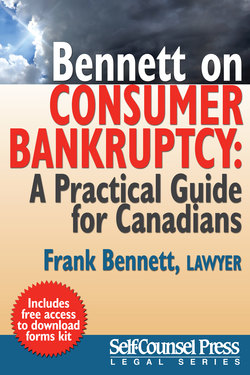Читать книгу Bennett on Consumer Bankruptcy - Frank Bennett - Страница 15
На сайте Литреса книга снята с продажи.
7. Information You Will Need to Share at a Bankruptcy Interview with a Trustee or Lawyer
ОглавлениеBankruptcy laws generally provide that transactions entered into by a debtor within five years of the date of bankruptcy require review by the trustee on behalf of the creditors. The trustee is concerned about property that the consumer debtor had, what the consumer debtor received for it when it was transferred, and where it is today. It is improper, generally, for a consumer debtor to give away property or transfer property at less than its fair value at a time when the consumer debtor is having financial difficulties and cannot readily pay his or her creditors. If the consumer debtor does not have sufficient assets at the time of the transfer or gift, then it is possible that the trustee or the creditors may move to set aside that transfer. If the transfer is set aside, the property re-vests in the name of the consumer debtor and thereafter the trustee or creditors can force its sale. Accordingly, a careful review of all assets should be made within five years of the projected date of bankruptcy. This would include the following:
• Full particulars about the consumer debtor including:
• surname, given names, nicknames
• address including postal code
• telephone and fax numbers, email addresses
• driver’s licence number
• social insurance number (show card)
• date of birth, with birth certificate
• passports, citizenship, or landed immigrant papers
• marital status, and where appropriate, separation agreement, divorce order, support order
• dependents’ names, relationship, and ages
• occupation
• name of employer including telephone and fax numbers, email address, and postal address
• salary, wages, or other remuneration
• full particulars of spouse, partner, or friend including names, date of birth, and social insurance number
• income tax returns for the last five years
• Full particulars of all assets in Canada and elsewhere, including:
• cash, bank accounts
• insurance policies for life and property, and names of beneficiaries and relationship
• furniture and furnishings
• securities including stocks, guaranteed investment certificates (GIC), shares of public and private companies
• bonds, over the last five years including brokerage statements
• vehicles, licence plates, ownership, and insurance particulars
• real estate
• leasehold
• equipment
• receivables and IOUs
• personal assets including collections having a value of more than $500, collections of silver, crystal, gold, coins, liquor, guns, art, and artifacts
• credit cards
• copies of net worth statements provided to any bank, lender, or other creditor
• copies of pass books or bank statements in the consumer debtor’s name alone or jointly with others
• copies of all credit card statements in the consumer debtor’s name
• Full particulars of all debts including names of creditors in alphabetical order, addresses, and amounts outstanding.
• RRSP, RRIF, and other pension statements for the last five years including documentation with respect to any change in the names of beneficiaries. The trustee and creditors cannot attach RRSPs except for monies invested within one year of bankruptcy.
• Full particulars of all dispositions and transfers of property within 12 months of taking protection and within 5 years of taking protection.
• Delivery of all credit cards, ownership registrations, mortgages, title deeds, guarantees, insurance policies, tax returns, and all other documents evidencing ownership and debt.
